This is a quick update on planting and emergence of first-planted corn fields:
First-Planted Corn/Soybean Fields:
The corn and soybeans planted on April 11-13th have, or are, emerging. See photos below:
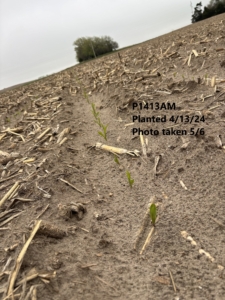
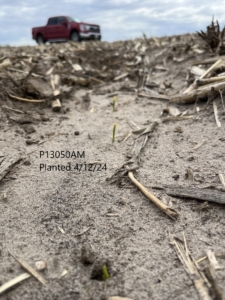
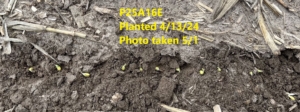
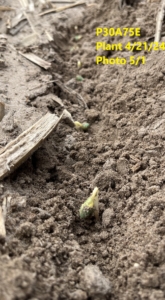 (second corn photo was taken on 5/1)
(second corn photo was taken on 5/1)
The corn planted April 11-13 appears to coming through in good shape from our observations. It only took two-and-a-half weeks for this to emerge, which is very much ‘not-the-norm’ historically for those planting dates. It will take that amount of time, or slightly more, for the corn planted April 22-25 to emerge. The reason for this is in the graphs below:
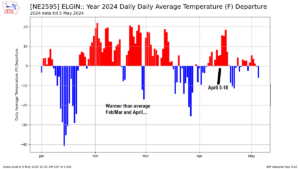
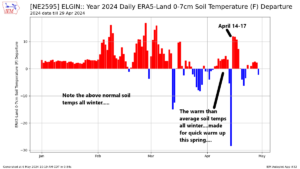
The first graph shows the daily average temperature departure from January 1st to May 6th. Not the warmer than average temperatures through Feb/Mar and into middle of April. The second graph shows daily soil temperature departure from normal from January 1 to May 6th. This shows that we never experienced a hard-freeze and this allowed the soil temperatures to start out warmer than average and help maintain that into April, as was mentioned at the Crop Shop in March. Note the strong soil temperatures in front half of April, this allowed the crop planted April 11-13 to get off to a fast start….In contrast, note the lack of the same heat from April 20th on….daily temps and soil temps have been normal during this time frame…which has slowed crop emergence down.
Planting Progress:
After a rapid planting pace from April 21-25th, corn/soybean planting has been stopped, or has been hit-and-miss, over the past 7-9 days. It has been many years since we have seen conditions turn this wet. Water is standing in places that we haven’t seen for quite some time….
The charts below give us a sense of why this is….
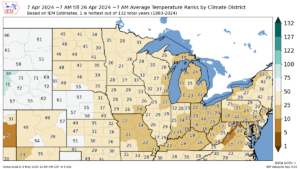

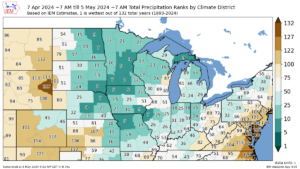
The first chart is average temperature rank by climate districts from April 7 to April 26. Our climate district had the 31st hottest out of 132 years during this time period. The second chart shows the average temperature rank by climate district from April 20 to May 5th. Our climate district, during this time period, was 67th hottest out of 132 years….very much the normal as reflected in the graphs discussed above.
The third chart shows total precipitation rank by climate district from April 7 to May 5. This gives us a sense of how wet conditions are, as we are experiencing the 7th wettest out of 132 years during this past month. As mentioned above, this is something we have not seen for quite some years…
Current GDU Accumulation:
Planting Date: 2024 GDU Normal GDU
April 12 173 174
April 22 95 103
Considerations for Planting moving forward:
- The recent rains have come heavy enough to cause quite of bit of washouts – both of rows and silted in bottoms. This too, is something that we have not seen on such a wide basis for quite some time. We have received many calls on this; however, any replant decision really must wait until crop emergence to fully understand the scope of any potential replant. Running a harrow can help in those spots with exposed kernels….while not ideal by any means, this has helped in keeping adequate stands without having to replant.
- Best management practices to consider if conditions stay wet:
- Any tillage ahead of the planter should be no more than what can get planted that day…this eliminates having to re-open ground to dry out if rains keep occurring, which leads to more ‘rocky’ soil conditions.
- Keep in mind sidewall compaction in the heavy soils moving forward. The tendency is to go out 1-2 days too early, before soil conditions are ready. Under these conditions in years’ past, we have noticed plant stands improving each day after the first day back out….the first fields planted after a rainy period are usually the fields that struggle the most to emerge and have full stands, vs. each day after that first day back in the field.
- We are still in the window for full yield on corn planting. We don’t reach significant yield reduction from planting date until we reach mid-May and after.
- Research has shown that it is best to stay with planned hybrids, regardless of maturity, through the later-half of May. Best performance is still to be found in planting mid-to-full season hybrids through May 22nd in our area. Corn has a natural tendency to adapt during the growing season to planting dates. See link below for more information. One should not be too ready to change maturity until after May 20th…best things to watch are silking dates & GDU’s to maturity, on the hybrids you are planting.
- Keep in mind that the recent rains will lead to greatly increased potential for crusting. One can already tell areas where the crust is starting to harden. It takes approximately 120-130 GDU’s for corn emergence (given average soil temperatures)….the corn (and soybeans) planted April 22 and after, will start to emerge next week. Check for potential crusting issues beginning over this weekend with the heat that is predicted. One will want to be slightly ahead of any potential emergence with water if needed….
- The recent rains will also cause the top to be more ‘fine textured’, leading to increased risk of sifting and blowing in areas where residue is reduced…again, this is something we haven’t had to deal with for some time….
Delayed Planting Considerations – Central Corn Belt
Please reach out to us with any questions on hybrids, maturity, planting conditions, etc., moving forward. Hopefully, we catch another window for planting starting end of this week in the heavy soils! Stay safe and have a productive continued planting season!
Starman Seed Service, Inc.

